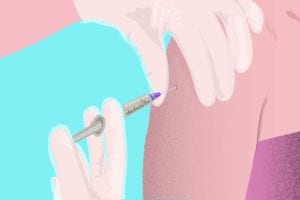When the virus that gave you chickenpox as a child (varicella zoster) reawakens in adulthood, it scoots along a nerve where it’s been lurking and triggers a rash in the area of skin fed by that nerve, causing an infection known as shingles. You may get an extremely painful stripe of blisters, or even worse — chronic pain from nerve irritation or long-term eye damage if shingles strikes there.
People with inflammatory arthritis are about twice as likely to get shingles as otherwise-healthy adults, which is likely due to immune dysfunction from the disease itself and/or the immune-suppressing drugs people take to treat their arthritis.
A shingles vaccine has been available to older adults for more than a decade and to those between 50 and 59 years old since 2011. However, many people with inflammatory arthritis haven’t been able to take advantage of the protection because of fears that the vaccine (Zostavax), which is made from weakened but live virus, could actually cause an infection in someone taking immunosuppressive drugs, such as tumor necrosis factor (TNF) inhibitors.
Now, reassuring data on that concern has emerged from a study presented at the 2019 American College of Rheumatology/Association of Rheumatology Health Professionals Annual Meeting in Atlanta.
“A major goal of the trial was to understand the safety of this live virus vaccine and to see if it caused infection in any of the participants,” lead study Jeffrey R. Curtis, MD, MS, MPH, a professor of medicine in the division of clinical immunology and rheumatology at the University of Alabama at Birmingham (UAB), told the American College of Rheumatology in a press release.
The study enrolled 617 patients, average age 62, who had never been vaccinated against shingles and were taking a TNF inhibitor for rheumatoid arthritis, psoriatic arthritis, or another condition. After receiving either the live vaccine or a placebo injection, participants were followed for six weeks — the amount of time the Food and Drug Administration considers people at risk for vaccine-related infections. All suspected infections were examined by the researchers, and any rashes were swabbed and genetically tested for both the strain of zoster virus used in the vaccine and that found in non-vaccine-related shingles.
The encouraging results: zero cases of shingles or a local zoster infection near the injection site. Eight patients developed a rash, but none were positive for the virus.
“The clinical significance of the trial is to provide high-quality direct evidence of the safety of this live virus vaccine in patients who previously were warned not to use it because of the theoretical risk for it to cause infection,” said Dr. Curtis, who is also co-director of the UAB Pharmacoepidemiology and Pharmacoeconomics Research (PEER) Unit and a cop-principal investigator of ArthritisPower, GHLF’s patient-powered research registry. “It also opens the door for the idea that for TNF-inhibitor users, perhaps other live virus vaccine also may be safe and might be considered in certain circumstances.”
The researchers are now planning a trial to study the safety and effectiveness of the newer non-live-virus shingles vaccine, Shingrex, in patients with arthritis and inflammatory bowel disease who were excluded from the clinical trials leading to its approval.
Get Involved in Arthritis Research
If you are diagnosed with arthritis or another musculoskeletal condition, we encourage you to participate in future studies by joining CreakyJoints’ patient research registry, ArthritisPower. ArthritisPower is the first-ever patient-led, patient-centered research registry for joint, bone, and inflammatory skin conditions. Learn more and sign up here.






